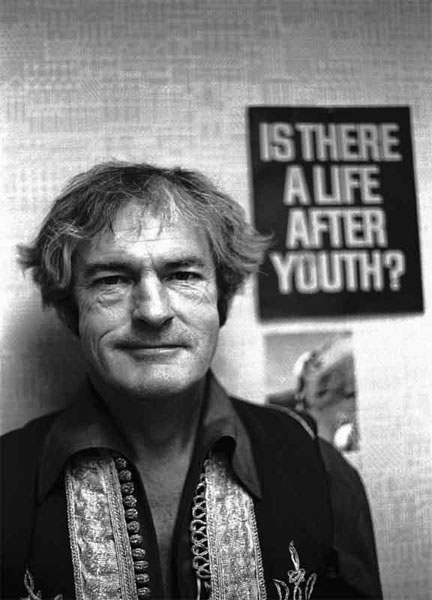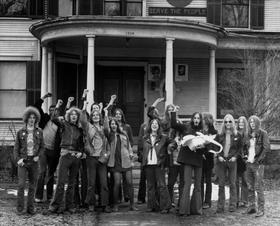Tune In, Turn On

If you are of a certain age, you will remember Timothy Leary with a mixture of fascination, awe or disgust. He was the High Priest of Acid, the original Turn On, Tune In, and Drop Out. He was an icon of the age, and the subject of the Moody Blues song “Legend of a Mind” that drifts still through my memory:
Timothy Leary’s dead.
No, no, no, no, He’s outside looking in.
Timothy Leary’s dead.
No, no, no, no, He’s outside looking in.
He’ll fly his astral plane,
Takes you trips around the bay,
Brings you back the same day,
Timothy Leary. Timothy Leary.
I was ruminating about Leary, and his role in the Mary Pinchon Meyer affair, reading Peter Janney’s strange narrative in my brown chair by the window, left leg elevated and ice on the knee. I had to put down the iPad twice to field telephone calls, cursing that I had not moved all my electronic devices to the coffee table where I could get at them without getting up.
The first call was a report from my on-the-ground correspondents in Ann Arbor, Michigan. It was the first Saturday of April, and the 41th iteration of the Hash Bash, a celebration of civil disobedience conducted at the central campus diagonal crossroads of the DIAG.
Let me go back. I was on campus for the first of the Bashes, a motley gathering of students protesting the arrest (and conviction) of local White Panther Party activist John Sinclair over the distribution of two marijuana cigarettes to an undercover agent.

John got ten years at Jackson Prison- nine and a half, actually, and his unexpected release came two days after a huge “Free John” benefit concert at Crisler Arena- the basketball venue called “the House that Cazzy Built” after the remarkable collegiate career of Wolverine Cazzie Russell, who led the Maize and Blue to three consecutive Big Ten Championships and two appearances in the NCAA Final Four.
Headliners at the concert were former Beatle John Lennon and Yoko Ono, backed up by Stevie Wonder and Bob Seger and Commander Cody and his Lost Planet Airmen. It was nuts- quite intoxicating to have that sort of star power supporting a local activist and musician.

(The Free John Concert. My pals and I are at the upper right someplace.)
The Arena opened in 1967- the year Detroit burned after the 12th Street riots. The time is a bit of a jumble now, with so much water over the dam. I got to Ann Arbor in the fall of 1969. It was a pretty crazy time to be living just about halfway between Plum Street, the Haight-Ashbury of the Motor City, and the White Panther Party headquarters at 1520 Hill Street. From the Chi Phi fraternity where we lived, you could have hit the WPP HQ with a well-thrown baseball.
You might think that this would be a long way around the rosebush to talk about Tim Leary, murdered socialite and Presidential lover Mary Pinchon Meyer and her estranged former husband and CIA honcho Cord Meyer, but it isn’t, really.
That was the subject of the second call I got Saturday. My pal Mac called to relate something about Operation Mockingbird. ”
You certainly covered a span of time — well over half a century,” he said. “The only survivor of the names you introduce may be Washington Post Publisher Ben Bradlee.” He paused in recollection. “I used to see Cord Meyer trudging the corridors of CIA when I was there in the 70s. Angleton was sneaking around also- you know I was there when Bill Colby fired him.”
“That is incredible, Admiral,” I said, doing a Kevin Bacon degree of separation between him and me and Cord Meyer.
“But they’re all gone now, the good-maybe- and the bad. The only one I didn’t know was the young lady who was murdered. I must have been soaking up Hawaiian sunshine when that happened, and the Honolulu papers didn’t report much from the Mainland. Was her assailant ever identified, found, or tried? Interesting history.”
“He was, and the conclusion is ‘maybe,’” I said, and I vowed I would get to the whole thing presently. In the meantime, I got sidetracked with the New York Times by Ben Stiel, who unravels the mystery of why an American did not traditionally head the International Monetary Fund, rather than The World Bank.
Simple, really. The architect of the Bretton Woods Conference was Harry Dexter White, and the IMF was the centerpiece of his vision for the post-war economic order. He was the likely candidate to head the new institution. There was a problem, though. Harry Truman was made aware of allegations that White had been an active Soviet Agent for years.
As an outcome, Belgian Camille Gutt, became the first head of the IMF and an American- not White- became the first head of the World Bank. It is interesting how the past informs the present, don’t you think?
I am not going to get to who killed Mary Pinchon Meyer today. There is a lot of interesting ground to cover to get there, and I assure you I have no revealed truth about anything. But it is worth showing the intersection between our external foreign intelligence service and campus life, and John Sinclair before we get back to Mary and her Presidential lover.
I have to explain some of the downstream consequences of a decade that unraveled starting the day Ike left office. In 1968, there was a discrete CIA recruitment office at 450 Main Street, Ann Arbor, Michigan, in those days. No one actually appeared to work there besides a receptionist, who would inform the curious that John F. Forrester, the Chief of Station, was not in the office. It was a bit like seeing Major Major in Heller’s Catch-22: if the Major was there, you could not see him. If he was out, you could go right in.
On that night in late September, someone set off four to six sticks of dynamite in front of Forrester’s office. The explosion was powerful, though nothing along the lines of the IED’s that have become so fashionable of late as a means of political expression.
The blast shattered windows and caused thousands of dollars worth of damage to the taxpayers. A few weeks later, the Institute of Science and Technology on North Campus was targeted. It was rumored to be an Air Force research facility, but of course that rubric could be used for all manner of things, including DoD support to the Agency.
The effort to find those responsible for the bombings targeted the avowed revolutionaries of the White Panther Party. Tipped off by a government informer, a federal grand jury indicted three members of the Panthers for the bombings. Defense Minister “Pun” Plamondon was a hippy from Traverse City. He was charged with having set off the bomb, and White Panther Minister of Education Jack Forrest was charged with conspiracy, along with Minister of Information John Sinclair.
When the indictment was handed down, Sinclair was already in prison, though his fame had spread internationally, and the big concert at Crisler Arena cemented his fame as a political prisoner. Pun Plamondon went underground for nearly a year to pleasure spots like Algeria after hearing about his the indictment on the radio. He even made the FBI’s Ten Most Wanted list, which he thought was pretty good for an average kid from Traverse City.
It is a pity, really, that DCI Richard Helms directed all the files on MKULTRA be destroyed in 1973, ahead of the Rockefeller Commission’s investigation of the Agency’s clandestine experiments with psychedelic drugs. The Agency had distributed more than 300 grants for study of the impact of mind-altering substances on unwitting subjects.
That is how I wind up back on the towpath of the C&O Canal, looking dimly back through the years at the sprawled body of Mary Pinchon Meyers, and the impish figure of Dr. Timothy Leary. We don’t think of Tim Leary, high priest of acid, as a World War Two vet. He was, and even a West Point Cadet before he tangled with the honor court.
He wound up as a sergeant in the Army Medical Corps, and that is how Tim became associated with Cord Meyer, a decorated combat Marine who was blown up by a Japanese grenade on Guam. Do you remember that there were competing Veteran’s groups to the American Legion and the VFW? The American Veterans Committee directed a front group of the Communist Party (the AVG) that sought to harness returning servicemen to the one-world solution to the elimination of all wars.
Cord Meyer was one of the leaders of the organization, and with published work in The Atlantic, Cord’s patrician background and extensive connections with The Right People had people thinking he might be a contender for the Presidency of a future World Government.
The organization swelled to more than a hundred thousand members before the Korean War broke out, and the brief illusion of a UN-led world shattered on the rocks of the reality of the USSR and the DPRK. Membership diminished in the wake of the revelations of the House Un-American Activities Committee about the extent of Communist penetration of the US Government. Cord Meyer was disenchanted with the AVG, and needed a job. He got one from Allen Foster Dulles at CIA, who was busily filling a bench with the best and brightest from the Ivy Leagues.
That is where Cord wound up, working first for Frank Wisner, and then being put in charge of things like Operation MOCKINGBIRD. He was also involved with MKULTRA, a program with its roots in the attempted exploitation of the U-Boat crews and other Germans who wound up in the Camp That Did Not Exist down at Fort Hunt, known then and now as “Post Office Box 1142.”
It grew. Operation PAPERCLIP (and the parallel Navy scientific collection missions in Europe) not only brought V2 scientists, but others, who had used concentration camp inmates for human experimentation.
Anyway, that is how the very strange story goes, as related by Leary, about Mary Pinchon Meyers and her attempt to organize a cell of well-placed Washington ladies to turn on and tune in their powerful husbands. For Mary’s part, the story goes that she smoked two joints with President Kennedy, and got him to try a mild dose of LSD. He reportedly looked out the Truman Balcony of the White House, impressed with elements of the remarkable view that had not been apparent before.
MKULTRA was proceeding apace as well, and continued right up through the time that Mac arrived at CIA.
I do not claim to know who killed the President of the United States, though it is plain enough to me on viewing the famous Zapruder film that JFK was hit from fore-and-aft.
That, in turn, means the existing narrative requires alternation, and that there was a conspiracy to commit political murder by persons unknown. I also do not know if his alleged lover actually was trying to expand his mind and consider Tim Leary’s expanded consciousness in the context of the great struggle with the Communists, nor if Mary was murdered in an attempted rape or robbery, or if elements of the Government deemed her a person who knew too much.
It is all so queer, the way people died and their papers, diaries and records seemed to disappear.
Marylyn Monroe, for one. That is still a very strange sidelight to a very strange story. Dorothy Kilgallen, for another, the game show panelist and journalist who interviewed Jack Ruby in his jail cell. Her body was found holding a book she had already completed, and she was not wearing her reading glasses. She said she would blow the lid off the Ruby story. Her notes seemed to have got lost. And of course, Mary Pinchon Meyer and her detailed diary of what she had been up to in Georgetown before and after the assassination of her paramour. James Jesus Angleton seemed to have wound up with the diary.
Curious, don’t you think?
We will have to talk more about that tomorrow. Those were some really strange days.
Timothy Leary’s dead.
No, no, no, no, He’s outside looking in.
Timothy Leary’s dead.
No, no, no, no, He’s outside looking in.
He’ll fly his astral plane,
Takes you trips around the bay,
Brings you back the same day,
Timothy Leary. Timothy Leary.

(1520 Hill Street, Ann Arbor, with White Panthers and the MC5.)
Copyright 2012 Vic Socotra
www.vicsocotra.com
